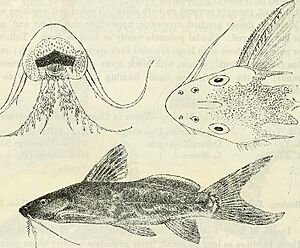Synodontis soloni facts for kids
Quick facts for kids Synodontis soloni |
|
|---|---|
 |
|
| Conservation status | |
| Scientific classification | |
| Genus: |
Synodontis
|
| Species: |
soloni
|
The Synodontis soloni, also called the scissortail synodontis, is a special type of upside-down catfish. It lives only in the Democratic Republic of the Congo. You can find it in the Ubangi River and in the fast-moving water near Stanley Pool.
A scientist named George Albert Boulenger first described this fish in 1899. He was a British-Belgian zoologist. He found it in the Congo River. The name soloni was given to honor Alexandre Solon. He helped collect fish for Boulenger.
What Does the Scissortail Synodontis Look Like?
Like other Synodontis fish, the scissortail synodontis has a strong, bony head. This head bone goes all the way back to its first fin spine. It also has a unique bony bump on its head called a humeral process. This bump's shape helps scientists tell different Synodontis species apart. For S. soloni, this bump is rough and much longer than it is wide. It also has a pointy end.
This fish has three pairs of barbels, which are like whiskers. One pair is on its upper jaw, and two pairs are on its lower jaw. The upper jaw barbels are long and straight. They have a wide base and are a bit longer than the fish's head. The outer pair of lower jaw barbels is almost twice as long as the inner pair. These barbels have small branches.
The front edges of the dorsal fin (on its back) and pectoral fins (on its sides) are stiff spines. The dorsal fin spine is a bit shorter than its head. It is smooth in front and rough on the back. The rest of the dorsal fin has seven soft rays. The pectoral fin spine is also a bit shorter than its head. It is rough on both sides. The adipose fin, a small fleshy fin, is about four and a half times longer than it is deep. The anal fin has three unbranched and seven branched rays. It is somewhat pointed at the front. The tail, or caudal fin, has a deep V-shape.
All Synodontis fish have a special pad of teeth on their upper jaw. These are short, chisel-shaped teeth. The S. soloni has three or four separate rows of these teeth. On its lower jaw, the teeth are S-shaped or hooked. They are attached to flexible stalks. Scientists count these teeth to identify species. The S. soloni usually has about 18 to 20 teeth on its lower jaw.
The fish's body is olive-grey on top, with brown patterns. Its belly is white. Its dorsal and tail fins have round brown spots.
The scissortail synodontis can grow up to about 15.5 centimeters (about 6 inches) long. Female Synodontis fish are usually a bit bigger than males of the same age.
Home and Habits of the Scissortail Synodontis
In the wild, you can find the scissortail synodontis in the fast waters of Pool Malebo and near Libenge. It also lives in the lower Congo River area and the Ubangi River.
People sometimes catch this fish for food. The main dangers to this fish are pollution in its rivers and the building of dams.
Scientists don't know much about how most Synodontis species reproduce. We know that females can carry many eggs. They likely lay their eggs during the rainy season, which is usually from July to October. During this time, pairs of fish might swim together to lay eggs. Young fish grow quickly in their first year. After that, their growth slows down as they get older.


